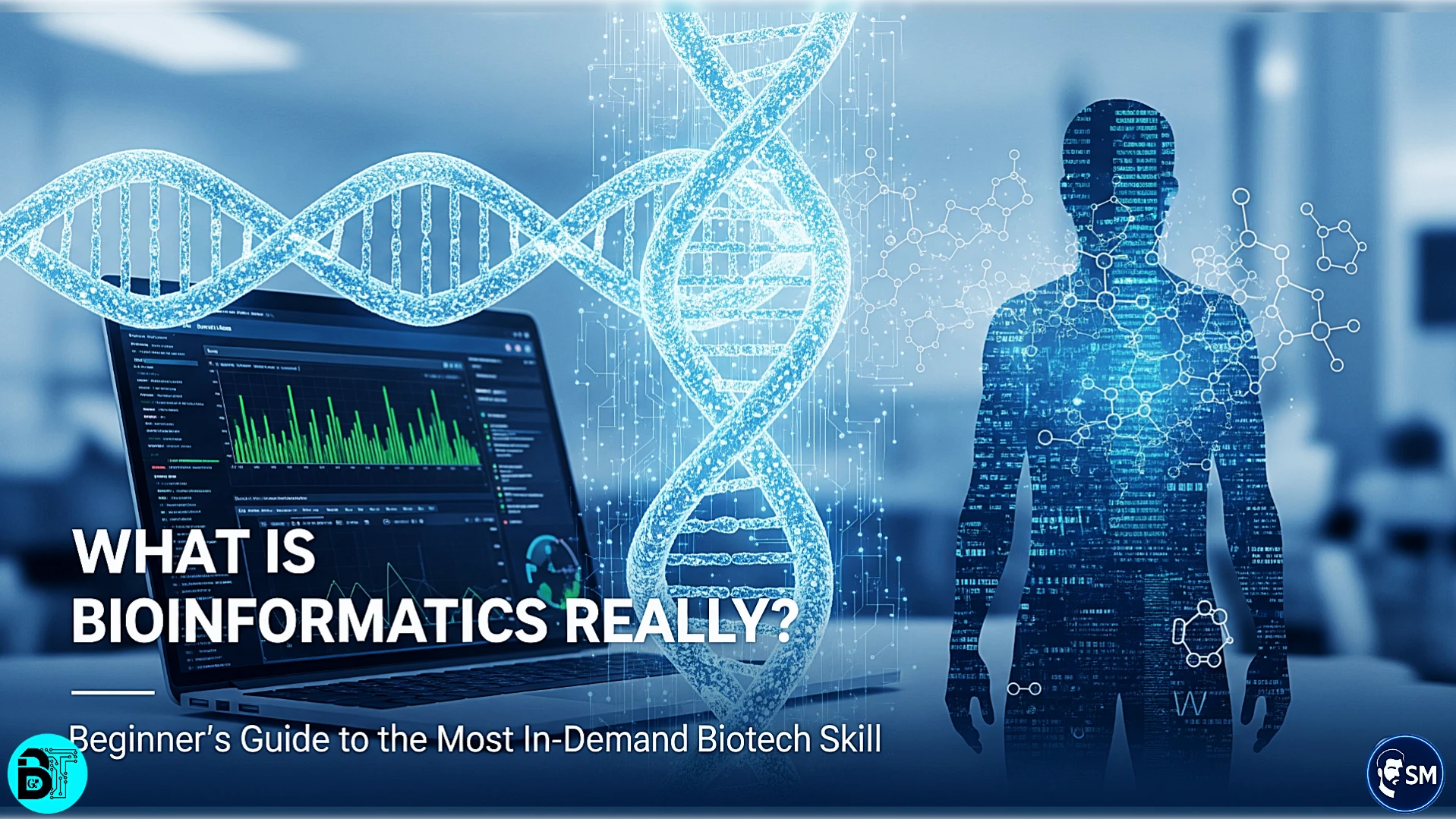What is Bioinformatics? Beginner’s Guide to Top Biotech Skills in 2025

A Beginner’s Map to the Most In-Demand Biotech Skill
Bioinformatics is the intersection of biology and computer science – a field where data meets DNA. In simple terms, it combines biology and computing to make sense of huge biological data.
For example, bioinformatics tools let scientists analyze DNA and protein sequences to understand genes or predict protein structures. This field has exploded in importance because modern biology generates massive amounts of data (like genomic sequences and lab measurements) that only computers can handle efficiently. As one biotech news source puts it, bioinformatics “integrates computer technology to analyze biological data, particularly DNA and protein sequences.” In practice, bioinformaticians help transform raw data from research (for example, a patient’s genome sequence) into practical insights (such as disease risk or drug targets) – and that is why this career is gaining global attention.
According to a 2025 market report by Acumen Research & Consulting, the global bioinformatics industry was valued at approximately USD 13.6 billion in 2023 and is projected to reach nearly USD 44.5 billion by 2032, growing at a robust compound annual growth rate (CAGR) of 14.3%. This growth is driven by increased demand across genomics, AI-powered drug discovery, and personalized medicine—highlighting bioinformatics as one of the most rapidly expanding fields in biotechnology and data science.
Bioinformatics is winning attention worldwide because our world is full of biological data and new AI tools to analyze it. Faster and cheaper DNA sequencing, large biomedical databases, and advances in AI/ML mean there’s more to discover. Hospitals and companies are using bioinformatics for everything from tracking pandemics to designing medicines. Big names are investing heavily – major biotech and pharma companies like Illumina, Qiagen, Thermo Fisher, and others have built out large bioinformatics teams. At the same time, the global bioinformatics industry is booming: a market research report notes the field’s value was $16.3 billion today and is expected to approach $24 billion within 5 years. In short, as one report notes, “these days, most biotechs rely on bioinformatics” for drug discovery and research.
Major Trends in Bioinformatics
Bioinformatics is riding the wave of several big trends: AI and machine learning, big data, and personalized medicine.
AI & Machine Learning:
Modern AI methods (like deep learning) are revolutionizing how we analyze biological data. As one industry expert explains, “AI and ML, in particular, have been pivotal in advancing genomics and proteomics. Machine learning algorithms can process vast arrays of genetic information to identify patterns and predict outcomes impossible for human researchers to discern.” In drug discovery, for example, AI models can scan huge libraries of molecules to predict which ones might become effective drugs. In biology, tools like AlphaFold (an AI protein-structure predictor) have shown the power of data-driven approaches.
Big Data & Cloud Computing:
Biomedical data has become so large that traditional analysis isn’t enough. Big-data technologies (and cloud platforms like AWS or Google Cloud) are now used to store and crunch genomics, imaging, and health record data. One overview notes, “Big data analytics is another cornerstone that has dramatically influenced bioinformatics by enabling the management, analysis, and interpretation of massive datasets characteristic of modern biological research.” This means bioinformaticians often use specialized software (like Hadoop or Apache Spark, or domain tools like Nextstrain) to handle millions of DNA sequences or population-scale health records.
Precision/Personalized Medicine:
Healthcare is moving towards treatments tailored to each patient’s genetic profile. Bioinformatics is at the heart of this shift. Experts point out that as medicine focuses on personalized care, the demand grows for skills to analyze patient genomes and other omics data.
For example, in cancer therapy, doctors use bioinformatics pipelines to analyze a patient’s tumor DNA and suggest targeted drugs. As the industry report notes, “the healthcare industry increasingly focuses on personalized medicine,” which drives “a growing need for bioinformatics expertise to analyze genetic data and contribute to tailored treatment plans.”
Other Growing Areas:
Several other hot topics intersect with bioinformatics. Genomic epidemiology (tracking pathogen evolution and outbreaks using genome data) became critical during COVID-19 (e.g., Nextstrain Project). Agricultural biotech uses bioinformatics for crop and livestock genomics. Even environmental science and forensics use DNA analysis. In short, any field generating biological data is a new playground for bioinformatics.
Real-World Applications of Bioinformatics
What do bioinformaticians do? Here are some key applications, with examples:
Genome Sequencing and Analysis:
One of the most common tasks is making sense of DNA sequencing data. For instance, when a patient’s DNA is sequenced, bioinformatics software filters and aligns the raw reads to a reference genome. This process produces a list of genetic variants, which are then interpreted. A UK genomics education site explains that clinical bioinformaticians use software tools to “filter large quantities of genomic data – usually gathered through next-generation sequencing (like whole genome or exome sequencing)… to find meaning in this overwhelming amount of information and provide clinically actionable solutions.”
Drug Discovery and Design:
Bioinformatics is crucial in pharmaceutical research. For example, in silico analysis helps identify drug targets by comparing genomic or proteomic data between sick and healthy cells. Researchers use bioinformatics to find genes/proteins that could be targeted by drugs and then predict which chemical compounds might bind them. As one review notes, bioinformaticians in drug discovery aim to…
(1) Identify drug targets;
(2) Predict or refine drug candidates that act on those targets;
(3) Minimize side effects.
Precision Medicine (Genomics):
Bioinformatics enables personalized healthcare by analyzing individual genomes. For example, bioinformatics pipelines can match a patient’s tumor mutations to potential targeted therapies. Genetic reports (e.g., for rare disease diagnosis) are generated by bioinformatic analysis of whole-exome or whole-genome data.
Microbiome and Pathogen Tracking:
Bioinformatics tools analyze DNA from microbes and viruses. For instance, during disease outbreaks, scientists sequence viral samples from patients and use bioinformatics to monitor how the virus is mutating and spreading. Tools like Nextstrain provide “real-time monitoring and analysis of pathogen evolution… crucial for tracking the spread and mutation of viruses.”
Other Data Analysis:
Beyond DNA, bioinformatics methods apply to many biological data types: protein structures, imaging data, and even ecological datasets. This includes 3D protein prediction (e.g., AlphaFold), large-scale proteomics datasets, and the integration of clinical and genomic data. Bioinformatics also plays a major role in CRISPR gene editing, synthetic biology, and digital health.
Transitioning to Bioinformatics Without a Biology Degree
You don’t need a biology degree to start a career in bioinformatics. Strong computing skills are often more important. Because bioinformatics merges multiple fields, people from computer science, engineering, or data analysis backgrounds can pivot into it by learning some biology basics.
Build on Your Coding Skills:
If you’re already good at programming, data analysis, or statistics, you have a huge head start. Many bioinformatics roles prioritize skills in languages like Python or R, data processing, and algorithm design.
Learn Biology Basics:
To thrive, you’ll need a working understanding of biology concepts (genetics, molecular biology, genomics). Online courses from platforms like Khan Academy or MIT OpenCourseWare can help you learn quickly.
Focus on Interdisciplinary Skills:
Learn bioinformatics tools like BLAST, Bioconductor (R), Biopython, Snakemake, and genome browsers. Join GitHub projects or analyze public datasets to build your portfolio.
Consider Further Training (Optional):
Some pursue bioinformatics certificates or master’s programs, but many get in through practical skills and internships. Online credentials from Coursera, Harvard, or edX can also boost your resume.
Who’s Hiring Bioinformatics Experts?
Bioinformatics skills are in demand at both big companies and startups. In India, for example, leading life-science and biotech firms routinely hire bioinformatics analysts and engineers. Some Indian companies known for bioinformatics roles include Helix Infosystems, Geneva Biosciences, Mascon Life Sciences, Accelrys (BIOVIA) and academic institutes like the BioInformatics Institute of India. Internationally, major players with bioinformatics divisions include Illumina, Qiagen, Thermo Fisher Scientific (sequencing and diagnostics giants), and research centers like the Broad Institute. (Illumina, Qiagen, and Thermo Fisher in particular are noted for having robust bioinformatics teams.) Biotech startups in genomics, personalized medicine, and AI-driven drug discovery also frequently look for bioinformatics talent.
Here is an easy-to-read table summarizing some companies hiring in this space:
| Indian Companies (Hiring Bioinformatics) | Global Companies (Hiring Bioinformatics) |
|---|---|
| Helix Infosystems (India) | Illumina (USA) |
| Geneva Biosciences (India) | Qiagen (Germany) |
| Mascon Life Sciences (India) | Thermo Fisher Scientific (USA) |
| BioInformatics Institute of India | Broad Institute (USA) |
| Accelrys/BIOVIA (India) | 10x Genomics (USA) |
(Sources: industry job postings and reports. These companies are frequently cited as major employers in bioinformatics.)
Of course, many other organizations need these skills, including pharmaceutical companies (like Pfizer, Novartis), academic research labs, hospitals, and even tech firms with genomics projects. If you search job boards or LinkedIn for “bioinformatics analyst” or “computational biologist,” you’ll find roles in both established corporations and exciting startups around the world.
Job Market and Salary Outlook
The career outlook for bioinformatics (and related data-science fields) is very strong. Data on related occupations suggest rapid growth and competitive pay:
High Growth Projections:
The U.S. Bureau of Labor Statistics forecasts huge growth for data-related jobs. For example, “data scientists” are projected to grow 36% from 2023 to 2033, which is much faster than average. Similarly, “computer and information research scientists” (a category that includes many bioinformatics roles) are projected to grow 26% in the same period. In contrast, average growth across all fields is around 5%. These numbers reflect the surge in demand for data expertise, including in life sciences.
Expanding Industry Size:
Market research predicts that the global bioinformatics market (including software, platforms, and services) is set to surge. As noted earlier, it may nearly double from $16.3B to ~$24B within a few years. This expansion means more jobs in every sector: biotech firms, research institutes, hospitals, and even government labs will be creating roles for skilled analysts and engineers.
Strong Salaries:
Bioinformatics positions tend to pay well, reflecting the specialized skill set. Salaries vary by region and experience, but in tech hubs, median pay for bioinformatics scientists can be in the low six figures (USD). (For perspective, data scientists’ median pay is about $112,590 in the U.S., and computer research scientists’ median is about $140,910.) Even at the entry level, bioinformatics roles often start above typical biology technician wages. As one survey noted, bioinformatics salaries “outpace those in many other fields of science” due to the value of combining biology and data science.
Future Outlook:
Continued advances in genomics and personalized medicine will keep demand high. Industry analyses emphasize that ongoing growth in areas such as healthcare genomics, agricultural biotechnology, and environmental bioinformatics will drive even more job creation and likely result in upward pressure on salaries. In short, the data on growth and pay make a strong case: bioinformatics is one of the most in-demand areas in biotech and data science today.
Founder of BTGenZ. Passionate about simplifying biotechnology for the next generation and bridging the information gap for aspiring biotechnologists in India.

Engage with Our Community
Join the conversation and share your thoughts with the BTGenZ community!
Connect on LinkedInLoading commenting section...
Comments Section
No approved comments yet. Be the first to leave a comment!